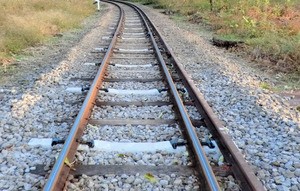鉄道 ― 線路(枕木)
<原文>
PDFファイルはこちらから→Click here for a PDF file.
鉄道の枕木「コンクリ製に交換を」 運輸安全委が提言
伊藤嘉孝 2018年6月28日10時03分
全国の地域鉄道で8カ月に4件も脱線が相次ぎ、国の運輸安全委員会は28日、レールを支える「枕木」を木製からコンクリート製に換えるよう促す提言書を石井啓一国土交通相に提出した。国交省は全国の鉄道事業者に対応を求める方針だ。

「枕木」の3本に1本を木製からコンクリート製に取り換えた「わたらせ渓谷鉄道」の線路。一部を交換するだけでも脱線防止に有効という(運輸安全委員会提供)
提言書などによると、和歌山県御坊市の紀州鉄道で2017年1月、1両編成の車両が左カーブを走行中に脱線した。調査の結果、木製の枕木が腐食したり割れていたりしていた。その結果くぎでレールを固定する力が低下し、外側にレールが傾いて2本の間隔が広がり、間に車輪が落ち込むように脱線したという。
1カ月後には熊本市の熊本電気鉄道で右カーブを走行中の2両編成が脱線。木製の枕木にレールを固定するくぎが緩み、レールが傾いて間隔が広がったことが原因だった。
17年5月には群馬県桐生市のわたらせ渓谷鉄道でも同様の事故が起きた。16年10月に岐阜県大垣市の西濃鉄道で同様の脱線が起きてから、約8カ月で4件も脱線が続いたことになる。
運輸安全委は対策として、線路の枕木を木製から、より耐久性が高く固定する力が強いコンクリート製へ交換していくことを提言。コスト的に難しい場合は、数本に1本の割合で交換するだけでも事故防止に有効だという。他の対策としては、脱線防止ガードの設置などを挙げた。
運輸安全委によると、都市部の鉄道では枕木のコンクリート化が進んでいるが、経営環境が厳しい地方の中小民間鉄道では、今も木製の枕木が高い割合で使われている。同委は、国や自治体の補助金や鉄道・運輸機構による技術支援制度などを活用できるよう、地方への情報提供を進めることも石井国交相に求めた。(伊藤嘉孝)
木製の枕木が関係した脱線事故
2016年10月 岐阜県大垣市 西濃鉄道で25両編成の貨物列車が脱線。けが人なし
17年1月 和歌山県御坊市 紀州鉄道で1両編成が脱線。乗客5人、けがなし
2月 熊本市 熊本電気鉄道で2両編成が脱線。乗客約50人、けがなし
5月 群馬県桐生市 わたらせ渓谷鉄道で作業車両が脱線。けが人なし
<訳文>
PDFファイルはこちらから→Click here for a PDF file.
"Replace wooden railway sleepers with those made of concrete," the JTSB proposes.
By Yoshitaka Ito | Jun 28, 2018 10:03
Japan had four derailments in eight months in its regional railways. In response to the successive occurrences of derailments, the Japan Transport Safety Board (JTSB) submitted a proposal to the Minister of Land, Infrastructure, Transport and Tourism of Japan, Keiichi Ishii for encouraging the replacement of wooden sleepers supporting rails with those made of concrete on June 28th. The policy of the Ministry of Land, Infrastructure, Transport and Tourism of Japan is to call on railway operators across the country to take actions.

The railway track of Watarase Keikoku Railway, where one in three wooden sleepers were replaced with concrete ones. It is said that replacing wooden sleepers, even if not all of them, will be effective to prevent derailments. (Courtesy of the JTSB)
According to the proposal and other documents, one-car rolling stock of Kishu Railway derailed while running around a curve in Gobo City, Wakayama Prefecture in January, 2017. The results of the investigation showed that corroded and/or cracked wooden sleepers had reduced the strength of spikes for fixing rails, tilting the rails outwards. The derailment occurred in such a way that a wheel was caught in the widened clearance between the rails.
One month later, a two-car train of Kumamoto Electric Railway in Kumamoto City derailed while running around a curve to the right. The cause of this accident was that loosening of the spikes fixing rails to sleepers tilted the rails, and widened the clearance between them.
In May, 2017, a similar accident occurred also on Watarase Keikoku Railway in Kiryu City, Gunma Prefecture. This was the fourth derailment that occurred during almost eight months since the first similar derailment had attacked Seino Railway in Ogaki City, Gifu Prefecture in October, 2016.
The JTSB proposes to start replacing wooden sleepers of railway tracks with those made of concrete, which are higher in durability and strength for fixing, as a countermeasure. When the cost is expensive, even replacing only one in some sleepers is effective to prevent accidents, the JTSB says. Other measures raised included installation of guard angles.
According to the JTSB, although concrete sleepers have been widely adopted by railways in urban areas, small to medium-sized local railways that are faced with difficult business environments still use a high ratio of wooden sleepers. The JTSB also requested Minister of Land, Infrastructure and Transport of Japan, Ishii to promote the provision of information to local operators so that they can make use of subsidies from the Japanese government and local governments and technical assistance programs provided by the Japan Railway Construction, Transport and Technology Agency. (Yoshitaka Ito)
Derailment accidents associated with wooden sleepers
Oct 2016: In Ogaki City, Gifu Prefecture, a 25-car freight train of Seino Railway derailed. Nobody was hurt.
Jan 2017: In Gobo City, Wakayama Prefecture, a one-car train of Kishu Railway derailed. None of five passengers were hurt.
Feb 2017: In Kumamoto City, a two-car train of Kumamoto Electric Railway derailed. None of approx. 50 passengers were hurt.
May 2017: In Kiryu City, Gunma Prefecture, Watarase Keikoku Railway's rolling stock for working derailed. Nobody was hurt.